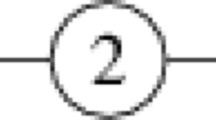Abstract
A model of informational control in network structures is analyzed. The result of informational control depends on the principal’s awareness and the influence levels of network structure elements (agents). Finally, the issue of beneficial network structures (from the principal’s viewpoint) is studied.
Similar content being viewed by others
References
Burkov, V.N., Osnovy matematicheskoi teorii aktivnykh sistem (Foundations of the Mathematical Theory of Active Systems), Moscow: Nauka, 1977.
Gubanov, D.A., Novikov, D.A., and Chkhartishvili, A.G., Sotsial’nye seti: modeli informatsionnogo vliyaniya, upravleniya i protivoborstva (Social Networks: Models of Informational Influence, Control and Opposition), Moscow: Fizmatlit, 2010.
Jackson, M., Social and Economic Networks, Princeton: Princeton Univ. Press, 2008.
Gubanov, D.A., Novikov, D.A., and Chkhartishvili, A.G., Models of Influence in Social Networks, Upravlen. Bol’sh. Sist., 2009, vol. 27, pp. 205–281.
Burkov, V.N., Burkova, I.V., Gubko, M.V., et al., Mekhanizmy upravleniya (Control Mechanisms), Novikov, D.A., Ed., Moscow: LENAND, 2011.
Dolgin, A., Manifest novoi ekonomiki. Vtoraya nevidimaya ruka rynka (A Manifesto of New Economics. The Second Invisible Arm of a Market), Moscow: AST, 2010.
Volkov, F. and Krasheninnikov, P., Oblachnaya demokratiya (Cloudy Democracy), Ekaterinburg, 2010–2011, http://cdem.ru (cited August 23, 2012).
Kuz’minov, Ya.I., Bendukidze, K.A., and Yudkevich, M.M., Kurs institutsional’noi ekonomiki: instituty, seti, tranzaktsionnye izderzhki, kontrakty (A Course in Institutional Economics: Institutions, Networks, Transaction Costs, Contracts), Moscow: Vysshaya Shkola Ekonomiki, 2006.
Barabanov, I.N., Korgin, N.A., Novikov, D.A., and Chkhartishvili, A.G., Dynamic Models of Informational Control in Social Networks, Autom. Remote Control, 2010, vol. 71, no. 11, pp. 2417–2426.
Gubanov, D.A., Novikov, D.A., and Chkhartishvili, A.G., Informational Influence and Informational Control Models in Social Networks, Autom. Remote Control, 2011, vol. 72, no. 7, pp. 1557–1567.
Zuev, A.S. and Fedyanin, D.N., Models of Opinion Control for Agents in Social Networks, Autom. Remote Control, 2012, vol. 73, no. 10, pp. 1753–1764.
Fedyanin, D.N. and Chkhartishvili, A.G., On a Model of Stochastic Informational Control in Active Network Structures, Tr. Mezhd. Nauchn. Konf. “Upravlenie bol’shimi sistemami” (Proc. Int. Sci. Conf. “Large-scale Control”), Moscow: Inst. Probl. Upravlen., 2011, vol. 2, pp. 290–292.
French, J.R.P., Jr., A Formal Theory of Social Power, Psychol. Rev., 1956, vol. 63, no. 3, pp. 181–194.
Harary, F., A Criterion for Unanimity in French’s Theory of Social Power, in Studies in Social Power, Michigan: Inst. of Sociological Research, 1959, pp. 168–182.
DeGroot, M.H., Reaching a Consensus, J. Am. Statist. Assoc., 1974, vol. 69, pp. 118–121.
Berger, R.L., A Necessary and Sufficient Condition for Reaching a Consensus Using DeGroot’s Method, J. Am. Statist. Assoc., 1981, vol. 76, pp. 415–418.
Friedkin, N.E., A Formal Theory of Social Power, J. Math. Sociol., 1986, vol. 12, pp. 103–126.
Gilardoni, G.L. and Clayton, M.K., On Reaching a Consensus Using DeGroot’s Iterative Pooling, Ann. Statist., 1993, vol. 21, pp. 391–401.
Agaev, R.P. and Chebotarev, P.Yu., Convergence and Stability in Consensus and Coordination Problems, Upravlen. Bol’sh. Sist., 2010, vol. 30, no. 1, pp. 470–505.
Agaev, R.P. and Chebotarev, P.Yu., The ProjectionMethod for Reaching Consensus and the Regularized Power Limit of a Stochastic Matrix, Autom. Remote Control, 2011, vol. 72, no. 12, pp. 2458–2476.
Shiryaev, A.N., Veroyatnost’ (Probability), Moscow: Mosk. Tsentr Nepreryvn. Mat. Obrazovan., 2004, vol. 1.
Author information
Authors and Affiliations
Additional information
Original Russian Text © D.N. Fedyanin, A.G. Chkhartishvili, 2012, published in Problemy Upravleniya, 2012, No. 6, pp. 13–18.
Rights and permissions
About this article
Cite this article
Fedyanin, D.N., Chkhartishvili, A.G. A model of informational control in active network structures in case of an incomplete awareness of the principal. Autom Remote Control 74, 2155–2162 (2013). https://doi.org/10.1134/S0005117913120175
Received:
Published:
Issue Date:
DOI: https://doi.org/10.1134/S0005117913120175




